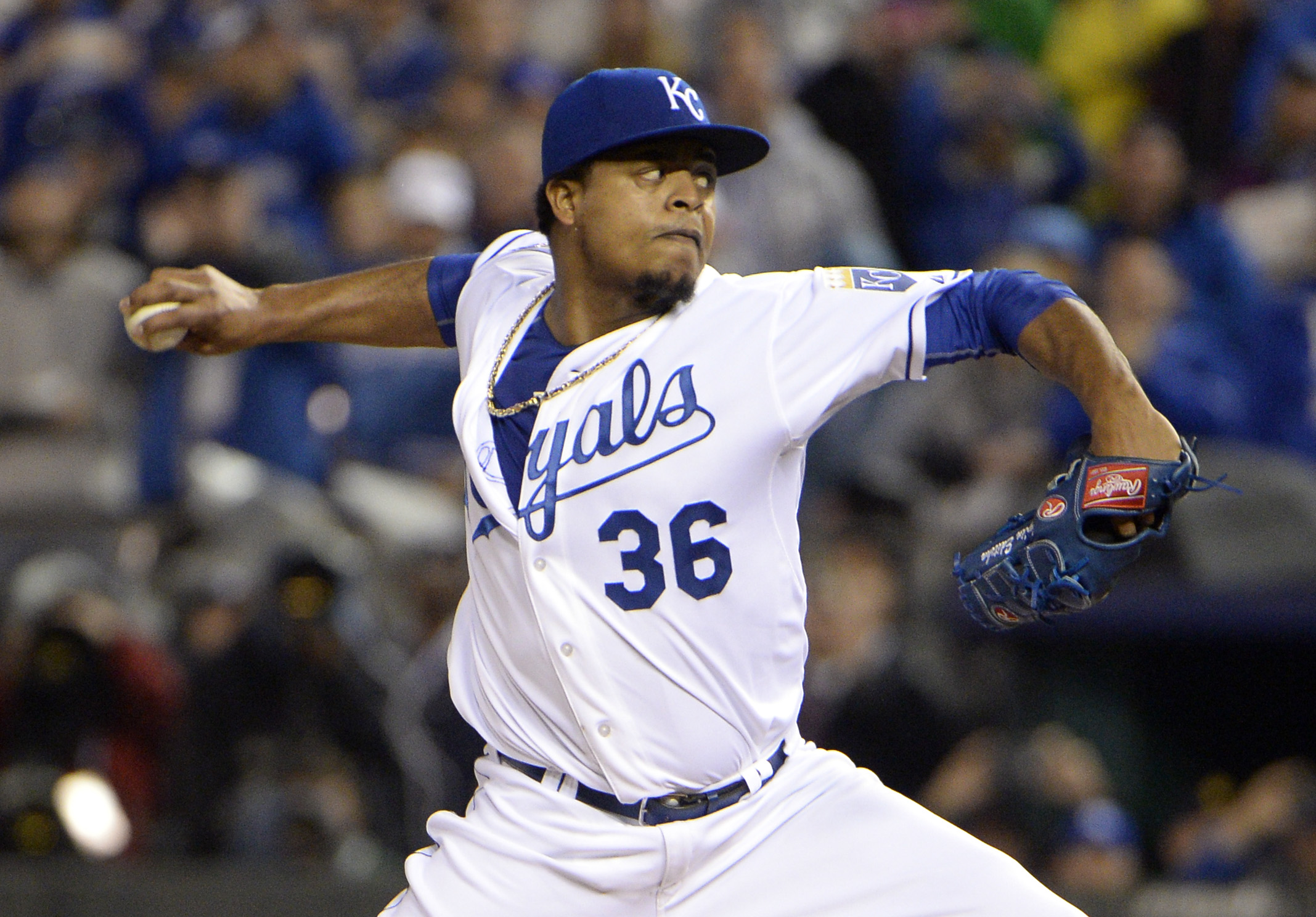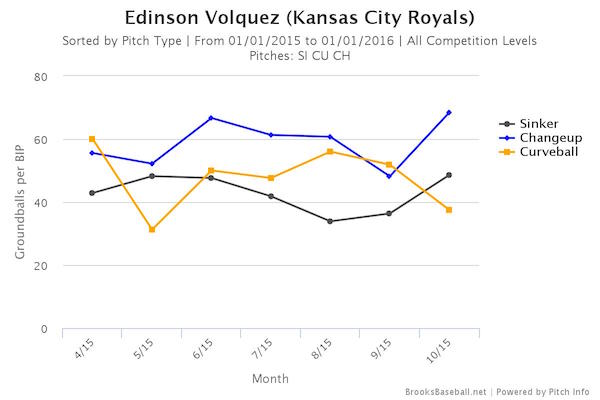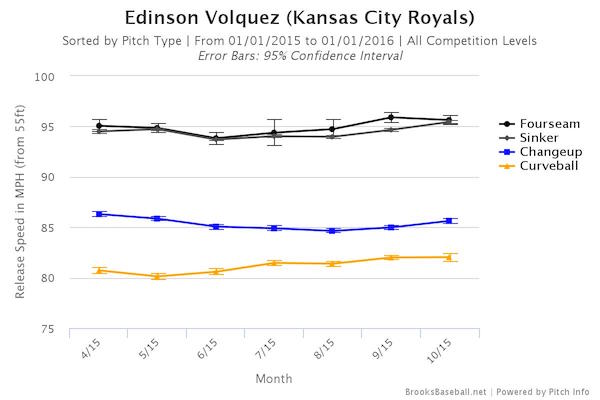“I feel sexy throwing down and away.”
— Edinson Volquez, following his Game One ALCS performance against the Toronto Blue Jays.
Over the weekend, the Royals named Sexy Ed Volquez their Opening Day starter. As appointments like this usually go, this one was unsurprising. Volquez is the veteran of the Kansas City rotation. He’s the guy they turned to as Game One starter in last fall’s ALCS and World Series. The intrigue to who would get the ball on Sunday night came down to him and last year’s Opening Day starter, Yordano Ventura.
As far as these things go, Volquez is the deserving starter. This will be his fourth Opening Day start. It’s been quite a journey.
When the Royals brought Volquez on board through free agency following the 2014 season, it seemed to be a risky – and potentially costly – move. At that time, Volquez was a much-traveled veteran of five clubs in seven major league seasons. Coming up through the Rangers organization, he was part of the vaunted DVD prospect trio. (John Danks and Thomas Diamond were the other two. You know what they say about pitching prospects.) After three cups of coffee in Texas, he was part of the package shipped to Cincinnati in exchange for Josh Hamilton. It was in Cincinnati where Volquez had his breakout season immediately following the trade, posting a 3.3 WARP in 196 innings with a 9.5 SO/9, a 3.21 ERA and a 3.60 FIP in 2008. His 2009 season would be derailed by Tommy John surgery.
Less than a year after having the procedure, he was back on the mound for the Reds. The rest of his tenure in Cincinnati was marked by inconsistency and struggles with command. Not a pitcher known for his strike-throwing ability before the Tommy John, perhaps his accelerated recovery lent to exacerbated issues with the strike zone. Volquez simply walked too many batters to be an effective pitcher. The numbers are frightening.
2008 – 4.3 BB/9
2009 – 5.8 BB/9
2010 – 5.0 BB/9
2011 – 5.4 BB/9
When the elbow is damaged and Tommy John is required, one of the warning signs before the injury is diagnosed and post-surgery side-effects is an issue with command. Volquez certainly had that. The bump in 2009 indicates he was probably pitching hurt. The elevated rate the next two seasons could be the result of a quick rehab and return to action. Even with the injury, struggles with command were a Volquez hallmark.
The Reds of five years ago were postseason contenders, and felt they couldn’t afford to continue to carry a scuffling starter. So Volquez was on the move again, this time to San Diego as part of a package for Mat Latos. Volquez rebounded slightly in San Diego, but that was more due to getting his home run rate under control (as tended to happen to pitchers with the Padres around that time.) However, his walk rate remained obscene at 5.1 BB/9.
Volquez struggled again the following summer. Finally, holding a 6.01 ERA in 142 innings, the Padres had seen enough. They designated Volquez for assignment and cut him free at the end of August. He was picked up by the division rival Dodgers and made six rather pedestrian appearances in September before hitting the free agent market.
The Pirates took a flyer on Volquez, signing him to a one-year, $5 million deal. His season in Pittsburgh was notable for a couple of reasons. One, he topped 190 innings for just the second time. Two, he finished with a 3.04 ERA, the best rate of his career. And finally and most importantly, he finished with a 3.3 BB/9, the lowest walk rate of his career. Actually, it was the first time he finished with a walk rate below four. Working with pitching guru Ray Searage, Volquez saw his soft contact rate jump from 15.5 percent in 2013 to 19.1 percent in 2014. Similarly, his BABIP tumbled from a career worst .325 to a career low .263.
Some may see luck in those peripherals. The Royals saw sustainable improvement. That singular season on the Allegheny earned Volquez a two-year, $20 million contract to pitch in Kansas City.
Searage earns plaudits for putting Volquez’s career on the right track, and deservedly so. But let’s throw a bouquet or two Dave Eiland’s way. Volquez in 2015 not only maintained his positive stride in walk rate, lowering it a tick to 3.2 BB/9, he harnessed the power of his secondary pitches to have his best all-around season since his 2008 breakout. His 3.79 FIP and 2.1 WARP were the second-best marks of his career.
Volquez throws a two-seam fastball that runs about 94 mph and complements that with a change-up and a curve. It’s the change that’s his bread and butter pitch. It runs about 10 mph less than his sinker, and with wicked downward action, it’s his true ground ball pitch. Last summer, nearly 59 percent of his change-ups put into play stayed on the ground.
Volquez will flip his change to batters from both sides of the plate and at any time in the count. Last year, opponents hit just .194 with a .236 slugging percentage when they connected on his off-speed offering.
Last October, Volquez made waves by flashing a little extra on his two-seamer. His average velocity jumped from 94 mph to around 95.5 mph.
His sinker is not a swing and miss offering, but the increased heat made the pitch virtually unhittable in October. During the regular season, opponents hit .306 off his two-seam fastball. In the postseason, he held them to a .220 BAA when throwing that pitch. Total, he threw 206 sinkers in the postseason. Two went for extra base hits.
The amped-up two-seamer allowed his other pitches to play large as well, especially his change.
October is a small sample size, but the takeaway is the changes Volquez made in Pittsburgh traveled with him to Kansas City. Two winters ago, Volquez didn’t know if he was going to continue to be a major league starter. Now, after putting together strong back to back seasons for the first time in his career, he’s back on solid footing. Over half of his 6.9 career WARP has come from his 2014 and 2015 seasons. Throw an impressive October in to the mix for good measure and while you may not have a true number one starter, you certainly have a pitcher who is more than deserving to front a rotation for the defending World Series champions.



